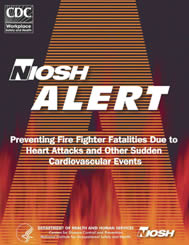






  |
 |
   |
|
 |
|
|
NIOSH Publication No. 2007-133:Preventing Fire Fighter Fatalities Due to Heart Attacks and Other Sudden Cardiovascular Events
|
June 2007
|
|
|
The National Institute for Occupational Safety and Health (NIOSH) requests assistance in preventing on-duty cardiovascular deaths among U.S. fire fighters. To reduce these deaths, NIOSH recommends that fire departments and fire fighters follow established medical screening guidelines, adopt risk reduction measures during fire fighting operations, and develop and participate in comprehensive wellness/fitness programs. To bring the information and recommendations in this Alert to the attention of the fire service community, NIOSH requests help from the following individuals and organizations: fire commissioners, fire chiefs, State and local fire district administrators, State fire marshals, safety and health officials, health care providers (physicians, nurses, etc.), human resource specialists, unions, labor organizations, insurance companies and editors of trade journals and other publications. |

|
|||||
Preventing Fire Fighter Fatalities Due to Heart Attacks and Other
|
.
Fire Departments should take the following steps to reduce on-duty heart attacks and other sudden cardiovascular events:
To help fire departments implement these steps, fire service agencies should conduct research on the following:
|
Introduction
Heart attacks and CAD are two conditions under the umbrella term, cardiovascular disease (CVD). Not all sudden cardiovascular events result in sudden death. In 2005, an estimated 765 fire fighters suffered an on-duty cardiovascular event that did not result in sudden death [Karter 2006]. In 1998, Congress funded the NIOSH Fire Fighter Fatality Investigation and Prevention Program to conduct investigations of on-duty fire fighter fatalities and formulate recommendations for preventing future deaths and injuries. From 1998 to 2004, NIOSH investigated 131 (43%) of the 304 sudden cardiac death fatalities. The NIOSH investigations included a review of the deceased fire fighter’s personal medical records. To share lessons from the NIOSH investigations, this document
Background
Cardiac and Cardiovascular Effects Associated with Fire SmokeFire smoke is complex mixture of heated gases, vapors, and particulate matter. The composition of the smoke is determined not only by the fuel source, but also by fire conditions (e.g. oxygen availability, temperature, etc.) [Kulig 1991; Levin 2005]. While hundreds of decomposition products are found, two of the more common and well known gases with cardiovascular effects are carbon monoxide and hydrogen cyanide. Carbon Monoxide
Hydrogen Cyanide Hydrogen cyanide is formed during the incomplete combustion of substances containing carbon and nitrogen (e.g., paper, cotton, wool, silk, plastics, etc). Hydrogen cyanide frequently has been detected in structure fires and levels have been shown to exceed established exposure limits [Jankovic 1991; Brandt-Rauf 1988; Gold 1978]. Like carbon monoxide, hydrogen cyanide disrupts the intracellular use of oxygen, resulting in intracellular hypoxia with cardiac manifestations [Purser 1984]. Particulate Matter
Cardiac and Cardiovascular Effects Associated with the Work EnvironmentIncreased Heart Rates and Heavy Physical Exertion
Heat Stress Heat stress and heat illnesses are well recognized hazards of fire fighting. Fire suppression can increase body temperature resulting in sweating and fluid loss, which can cause serum electrolyte changes, lower stroke volume (the volume of blood pushed during each contraction of the heart), or lower cardiac output [Rossi 2003; Smith 2001; Costrini 1979]. Heat stroke has been reported to increase the risk of myocardial ischemia, arrhythmias, and conduction abnormalities [Akhtar 1993].
Fire fighters’ noise exposures are obvious: sirens, air horns, diesel engines, and the roar of a large structure fire itself. During emergency operations, sound levels exceeding 120 decibels have been measured [Tubbs 1995]. Studies of community and occupational groups have found an association between noise exposure and hypertension, and possibly an association with ischemic heart disease [Van Kempen 2002; Davies 2005; Willich 2006; McNamee 2006]. It is important to note that fire fighters’ noise exposure (short duration, high intensity) differs from that studied in community and in other occupational groups [lower intensity for a longer duration (e.g. full-shift)]. However, given the extent of the noise-induced hearing loss found in fire fighters, it is plausible that noise exposure increases the risk of hypertension and possibly ischemic heart disease among fire fighters [Tubbs 1995]. Shift Work and Overtime
Environmental Tobacco Smoke In 2006, the Surgeon General confirmed a causal relationship between exposure to secondhand smoke and increased risks of coronary heart disease morbidity and mortality [USDHHS 2006]. An estimated 46,000 cardiac deaths occur each year due to secondhand smoke in the United States [Cal/EPA 2005]. Since not all fire stations are smoke free, involuntary exposure to tobacco smoke continues to present cardiovascular risks for fire fighters. Fire Fighting and Heart DiseaseOver 25 published studies examine the relationship between heart disease and fire fighting. Results of these studies are conflicting (e.g., some studies support the association while others do not). In 1995, Guidotti published a review of the fire fighter mortality literature. He concluded, “Sudden death, myocardial infarction, or fatal arrhythmia occurring on or soon after near-maximal stress of the job are likely to be [work] related…” [Guidotti 1995]. It is important to recognize, however, the limitations of the scientific method used in these studies. The major concern is a problem known as the healthy worker effect (HWE) [Choi 1992]. This problem arises because working populations are usually selected for employment in such a way that they have better health (corresponding to a lower death rate) than the general population to whom the workers are compared. For example, before placement, fire fighter candidates are screened for many cardiovascular conditions and risk factors (e.g., diabetes and hypertension). This leads to a strong healthy hired effect, one component of the HWE [Arrighi 1994]. In 2000, Choi re-assessed 23 standardized mortality ratio studies addressing the relationship between fire fighting and heart disease after attempting to control for the HWE. He concluded that, “(1) there is strong evidence of an increased risk of death overall from heart disease among firefighters; …. (3) there is insufficient evidence, even after considering the HWE, for a relationship between firefighting and any heart disease subtype, such as acute myocardial infarction” [Choi 2000]. Current Standards
|